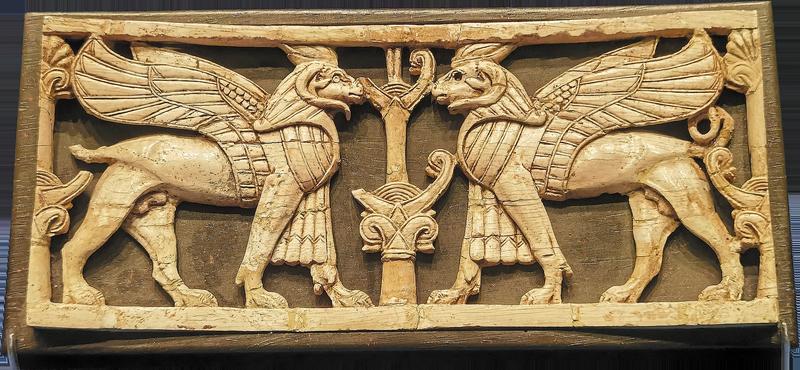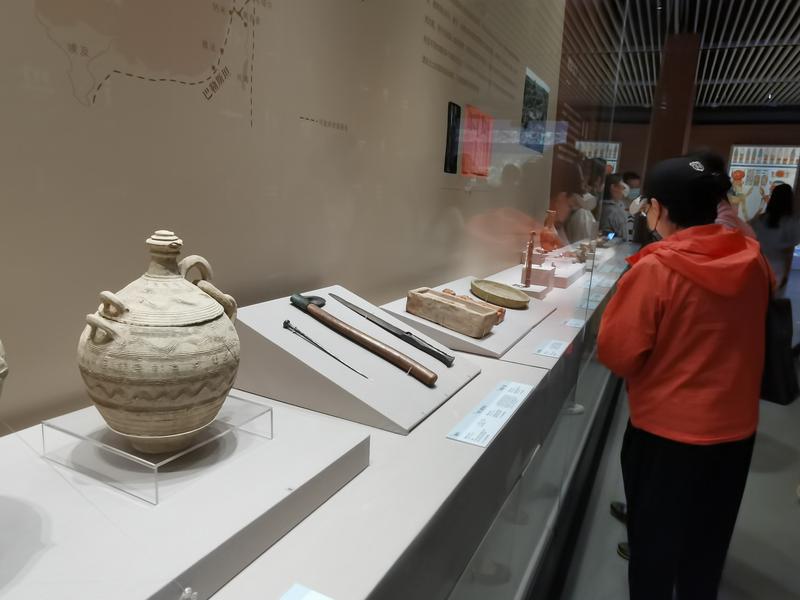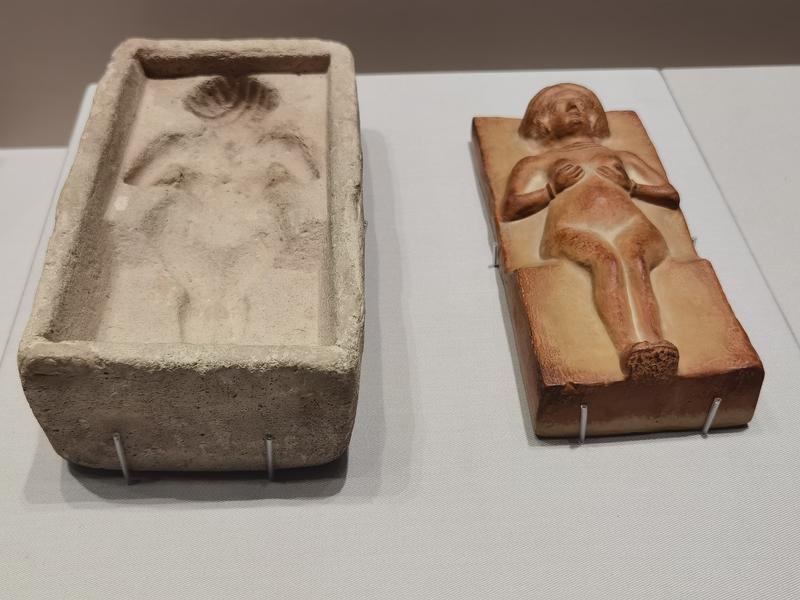Artifacts from ancient Syria on display in Beijing offer visitors a tantalizing glimpse of the remarkable civilization, Wang Kaihao reports.
 A relief portraying Sphinx from the 9th century BC, found in Syria, is among the highlights in Encounter Mesopotamia: An Exhibition of Antiquities From Ancient Syria, in Beijing. (WANG KAIHAO / CHINA DAILY)
A relief portraying Sphinx from the 9th century BC, found in Syria, is among the highlights in Encounter Mesopotamia: An Exhibition of Antiquities From Ancient Syria, in Beijing. (WANG KAIHAO / CHINA DAILY)
A 6,000-year-old clay wine vessel shaped like a hedgehog; a baker's mold that goes back four millennia; tablets inscribed using the logo-syllabic cuneiform script; or figurines that make a sartorial style statement. Take your pick to travel back in time.
An exhibition of 200 exquisite cultural relics from Syria, which officially opened to the public in Beijing in late June, spans eras and offers visitors a fascinating insight into the Mesopotamian civilization.
On loan from nine museums in Syria and on display at the National Library of China, these artifacts have weathered battles and wars, witnessed the rise and fall of empires, and withstood more than just one pandemic to inspire generations of history and archaeology enthusiasts.
Titled Encounter Mesopotamia: An Exhibition of Antiquities From Ancient Syria, the presentation is being co-organized by the national library and the Art Exhibitions China, which is a national-level institution in charge of cross-border display of cultural relics.
 About 200 cultural relics on loan from museums across Syria present the ancient civilization of that country for visitors to the National Library of China. (WANG KAIHAO / CHINA DAILY)
About 200 cultural relics on loan from museums across Syria present the ancient civilization of that country for visitors to the National Library of China. (WANG KAIHAO / CHINA DAILY)
The exhibition is particularly riveting because of the wide spectrum of history it covers. Stone tools from half a million years ago, dating back to the Paleolithic period, are on display along with artifacts from the Bronze and Iron ages. And then, there are relics from the time the region was influenced by Greco-Roman and Islamic cultures.
"Ancient Syria was not just a land of cuneiform clay tablets; it was a melting pot of various customs and traditions," says Tan Ping, director of Art Exhibitions China. "As a result, a brilliant civilization was born, with remarkable achievements in the fields of astronomy, mathematics, literature and fine arts, among others."
While magnificent murals and stone reliefs reveal how deities, kings and heroes were revered by an ancient civilization, several relics are historical documentation of mundane, everyday life in Mesopotamia. For example, a 4,000-yearold tablet simply records how a farm owner distributed his livestock.
Statues and figurines indicate a great degree of sartorial elegance, and an urban style that may not completely be outdated. Necklaces with lapis lazuli (a beautiful blue metamorphic rock used as a semiprecious stone in jewelry) demonstrate both opulence and outstanding craftsmanship.
 Statues of worshippers from the Bronze Age. (WANG KAIHAO / CHINA DAILY)
Statues of worshippers from the Bronze Age. (WANG KAIHAO / CHINA DAILY)
Pottery items-such as the fancy hedgehog wine container-not only shed light on the aesthetic inclination of Mesopotamian people, but also on the happening social life during the Uruk period, more than 5,000 years ago, seen as the beginning of civilization in the region.
While a bakery mold from 4,000 years ago can inspire any present-day pastry chef, a letter on a tablet, in which a servant discusses how to make a cast for bread with his master, is a remarkable testimony to the delicate taste the ancestors had.
In addition to the exhibits from Syria, artifacts from a couple of Chinese museums are also on display in a poignant reminder to the close connection between the two ancient civilizations.
These include a stele stone (a commemorative slab with information in the form of texts, images or combination of both) from the 8th century found in Xi'an, Northwest China's Shaanxi province. The stele records how the Nestorian Church, a Christian sect of east Syriac rite, was popular in China under the Tang Dynasty (618-907).
A stone tablet from the Xinjiang Uygur autonomous region reveals how ancient Syrian elements influenced its decorative pattern. The display even includes a chapter of the Old Testament, written in an ancient Syriac language, found in Dunhuang, Northwest China's Gansu province.
 A mold for bakery from 2000 to 1600 BC. (WANG KAIHAO / CHINA DAILY)
A mold for bakery from 2000 to 1600 BC. (WANG KAIHAO / CHINA DAILY)
In Shiji or Records of the Grand Historian, the monumental Chinese historical documentation written during the 1st century BC, Sima Qian referred to the region of present-day Syria as tiaozhi. It is the oldest surviving Chinese record of the ancient country.
According to Tan, China has in recent years actively launched projects in collaboration with Asian countries to preserve, study and display cultural relics. The latest exhibition has been organized to echo the commitment made by China during the Conference on Dialogue of Asian Civilizations in Beijing in 2019.
"The exhibition upholds the spirit of the ancient Silk Road communication, and emphasizes the importance of cultural exchange and mutual learning," Tan says. "It is crucial to the Belt and Road Initiative," he adds.
In October, the Asian Alliance for Cultural Heritage Conservation was established in Beijing. Ten countries, including China and Syria, were its founding members.
Before Beijing, the exhibition toured Shenzhen in Guangdong province and Chengdu in Sichuan province since August. It is the first large-scale display of Syrian cultural relics in the Chinese capital and will run until Oct 8.
Contact the writer at wangkaihao@chinadaily.com.cn


